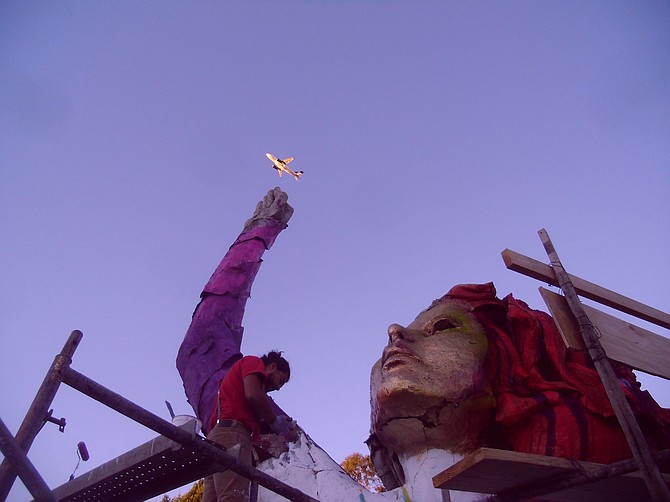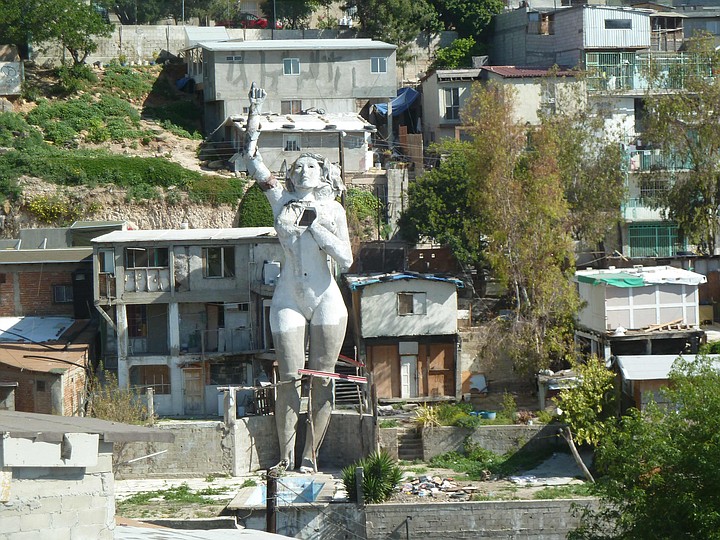 Facebook
Facebook
 X
X
 Instagram
Instagram
 TikTok
TikTok
 Youtube
Youtube


Tijuana III Millennium or “La Mona” is an iconic giant sculpture of a naked woman that doubles as a house. The sculpture is five stories tall and weighs over 18 tons. La Mona is located in Colonia Aeropuerto, near Tijuana's airport, and overlooks the city with her right arm extending up into the air. Armando Muñoz started building the giant lady in 1987 and finished it in 1991, with no help from the government. Armando does not live there anymore, but still uses the space as his office and to host tourists that visit his work.
In late October, his statue was covered in a giant pink dress for cancer awareness month. In the last week of November, La Mona got a new paint job from head to toe.

“Ava Ordorica approached me in person and told me about the art intervention, that's how it happened,” Armando Muñoz tells me via Facebook about how his famed sculpture got redone. “Then the artists that she told me about came and did their work. I didn't participate in it at all. Everything was done by the young artists that did a wondrous job. Work is incomplete though, her right hand and arm are still missing.”
Alfredo “Libre” Gutiérrez, an artist from Tijuana, was in charge of leading the international art intervention on the sculpture.
“It was ten of us total: Kenta Torii (Hiroshima), Tak (Tokio), Chirrete (Colombia), Dual (Rosarito), Persue (San Diego), Dhear, Dan, Nema (three from Mexico City), Lizardo Hernández and myself (Tijuana).” Libre often collaborates with other international artists in big interventions in Baja, other places in Mexico, California and more.
“My part [in La Mona] symbolizes day and night and the previous state of the sculpture. I also painted roses and curves with Tijuana's topography on her back.” The day and night are painted on the sculpture's arms and bare chest. The rest was painted by the collaborating artists.
The intervention was sponsored by Festival Tijuana Interzona's 8th edition, a 9-day festival with 50 artistic activities in over 30 spaces. “They (festival organizers) talked to Armando and financed the project. They paid Armando and the artitsts.” Libre explains the festival's participation with the intervention.
“Honestly, it came out way better than a digitalized rendered photo that they sent me prior the intervention. I really like it and I hope they finish the shoulder, hand and arm, as its the most symbolic part.” Armando Muñoz shares a final thought on the work.
I asked Libre about the hand situation; “the work is finished, I purposely left a space with the texture of how she used to be, a conceptual thought on her classic look. But me and Armando don't see eye to eye and I don't think he understood my concept.”
La Mona is easily seen over a hill on the road to Tijuana's airport from downtown Tj. Her bright new colors make it even easier to spot, contrasting the slummy looking hills.



Tijuana III Millennium or “La Mona” is an iconic giant sculpture of a naked woman that doubles as a house. The sculpture is five stories tall and weighs over 18 tons. La Mona is located in Colonia Aeropuerto, near Tijuana's airport, and overlooks the city with her right arm extending up into the air. Armando Muñoz started building the giant lady in 1987 and finished it in 1991, with no help from the government. Armando does not live there anymore, but still uses the space as his office and to host tourists that visit his work.
In late October, his statue was covered in a giant pink dress for cancer awareness month. In the last week of November, La Mona got a new paint job from head to toe.

“Ava Ordorica approached me in person and told me about the art intervention, that's how it happened,” Armando Muñoz tells me via Facebook about how his famed sculpture got redone. “Then the artists that she told me about came and did their work. I didn't participate in it at all. Everything was done by the young artists that did a wondrous job. Work is incomplete though, her right hand and arm are still missing.”
Alfredo “Libre” Gutiérrez, an artist from Tijuana, was in charge of leading the international art intervention on the sculpture.
“It was ten of us total: Kenta Torii (Hiroshima), Tak (Tokio), Chirrete (Colombia), Dual (Rosarito), Persue (San Diego), Dhear, Dan, Nema (three from Mexico City), Lizardo Hernández and myself (Tijuana).” Libre often collaborates with other international artists in big interventions in Baja, other places in Mexico, California and more.
“My part [in La Mona] symbolizes day and night and the previous state of the sculpture. I also painted roses and curves with Tijuana's topography on her back.” The day and night are painted on the sculpture's arms and bare chest. The rest was painted by the collaborating artists.
The intervention was sponsored by Festival Tijuana Interzona's 8th edition, a 9-day festival with 50 artistic activities in over 30 spaces. “They (festival organizers) talked to Armando and financed the project. They paid Armando and the artitsts.” Libre explains the festival's participation with the intervention.
“Honestly, it came out way better than a digitalized rendered photo that they sent me prior the intervention. I really like it and I hope they finish the shoulder, hand and arm, as its the most symbolic part.” Armando Muñoz shares a final thought on the work.
I asked Libre about the hand situation; “the work is finished, I purposely left a space with the texture of how she used to be, a conceptual thought on her classic look. But me and Armando don't see eye to eye and I don't think he understood my concept.”
La Mona is easily seen over a hill on the road to Tijuana's airport from downtown Tj. Her bright new colors make it even easier to spot, contrasting the slummy looking hills.
Comments